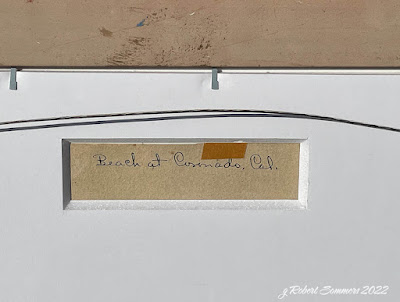I have sold all the greats of San Diego at one time or another, the four so-called deans of San Diego art, Fries, Braun, Mitchell and Reiffel, as well as the leading women, like Anni Baldaugh, Belle Baranceanu, Rose Schneider and Klauber. Other greats include Everett Gee Jackson, Baldessari, Hocks and Hord and I have been lucky and fortunate enough to sell works from them all.
I bought two watercolors with a partner in San Francisco a few weeks ago and picked them up at Modernism. They were both very early works by Lafayette Maynard Dixon (1875-1946), painted while he was still in his teens.
 |
| Storytellers |
I have been privileged to sell some very nice Dixon's in my time, one that landed very close to the front page of one of Gerry Peters's books on Dixon but nothing remotely in the aforementioned league.
Anyway, back to the matter at hand. These new early works of mine and my partner were both ostensibly from Alameda in the East Bay, executed in 1892, roughly the year that Dixon first took classes at the School of Design in San Francisco.
One was dated June and one October, 1892, both were views of Alameda Bay.
Or so I thought.
I am embarrassed to admit that I had no idea that he ever lived here, let alone painted here, especially at the ripe young age of 17. But so be it. This might be one of the earliest works of Maynard Dixon that has ever surfaced.
Now let me be clear. I do not think these are artistic masterpieces but I find them both lovely and curious from an academic standpoint and a case can certainly be made that his star and acclaim overshadows any of the other local masters of painting that I have previously mentioned.
And this whole quest has sent me down a nice little rabbit hole of exploration, one that I have just started to tread. What was the nature of the young Fresno native Dixon's appearance in San Diego County?
From Jeff Mitchell's website, (which includes an excellent early Coronado work from the same year)
As a somewhat frail child, Maynard Dixon was often left to his own devices and by the age of 6 had begun to draw, letting his imagination take him through the western landscape. In 1891, Dixon’s father had suffered a nervous breakdown, motivating the family to move to Coronado near San Diego to provide a more peaceful environment. That same year, Dixon had impressed the famous illustrator Frederic Remington with a portfolio of his work, receiving an encouraging response, and the advice, “… copy only from nature.” Quitting school, Maynard immersed himself in further improving his drawing and painting skills, exploring the region.
Much of his earliest work was destroyed in the 1906 San Francisco fire...
Richard Dillon wrote a book on Dixon in 1976, MAYNARD DIXON, Or From Coronado to Cañon de Chelly., which I have not yet read but plan on finding.
This sort of resonates with me as my mother's nervous breakdown brought me back to California in 1974. I did find an early biography online pdf at the Bancroft library that sheds a little more light. It was written during his lifetime and is entitled, No place to go.
I did find a very nice and well developed piece from Coronado titled Dawn on Pinterest but have no idea where it actually resides. That makes three Dixon works from San Diego County that I know exist.









4 comments:
What a wonderful discover.
Diane O
Great story… now I know more
Thank you
Robert,
That is the best part of doing what You/we do. I love to uncover the
history, provenance of these early pieces that in this case recorded
California's growth. This is before Fries, correct?
Very nice!
JS
Fries didn't come west from Cincinnati until 1896. He lived in the ruins of the San Juan Capistrano Mission for a year, arrived in San Diego the following year and stayed until he died in 1940. I should have mentioned that my wife and her family were residents of Coronado when I met her and her mother and father lived there until they passed.
Post a Comment